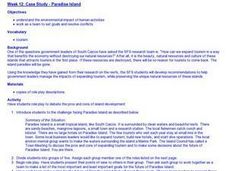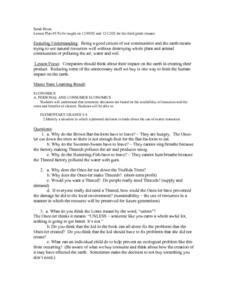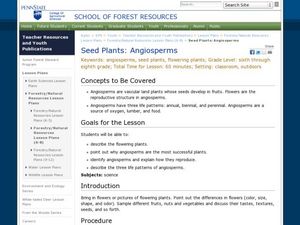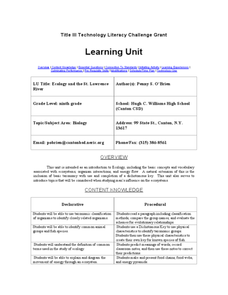Curated OER
Fish Swimming--A Poem by Moniza Alvi
In this poetry analysis worksheet, middle schoolers read the poem "Fish Swimming," and discuss the metaphors in the poem. Students complete eight activities based on the poem, including rewriting the subject of the poem and watching two...
Curated OER
Insect Food Chain & Camouflage
Students use art work to demonstrate their understanding of the insect food chain and their ability to camouflage themselves. In this insect food chain and camouflage lesson, students determine what type of animals feed on insects. They...
Curated OER
Case Study - Paradise Island
Students make a plan for the future of Paradise Island. Their recommendations should help government leaders manage the impacts of expanding tourism, while preserving the unique natural resources of this island.
Curated OER
Around the World
Students explore ways people from around the world are like them. They discuss how geography affects the way people live and work and how culture affects a person's day to day life. Students give a presentation over a chosen country to...
Curated OER
How Does a Seed Grow Into a Plant?
Second graders explore how seeds grow into plants. They discuss types of seeds and place seeds in wet paper towels to germinate. They draw a picture in their journal to record their observations for four days. They take pictures of their...
Curated OER
Economics -- Third Grade
Third graders read the Dr. Seuss book The Lorax. In groups, they answer questions that are related to economics and distribution of goods. They also identify the environmental issues present in the book and perform a skit in front of the...
Curated OER
Ice Energy
Students learn how science affects foods. In this chemical reactions lesson, students make two kinds of ice cream. They evaluate the different changes based on the ingredients.
Curated OER
Forests of the World
In this forests worksheet, students read a one page informational excerpt on different forests throughout the world. They then use what they learned to answer the 20 questions on the worksheet. The answers are on the last page of the...
Curated OER
Seed Plants: Angiosperms
Students describe flowering plants and see why angiosperms are the most successful plants. In this angiosperms lesson students identify angiosperms and explain how they reproduce.
Curated OER
Unit 5 - Food
Students study the biodiversity existing in the Amazon rainforest. In this Amazon biodiversity instructional activity, students study diagrams, maps, and information about the biodiversity in the Amazon.
Curated OER
Is Urban Sprawl Causing Us To Lose More Than Ground?
Young scholars map the changes that occur in the land as a result of urban sprawl. They explore the problems that paving and building have on the watershed and the habitats on the Northshore.
Curated OER
Positively Paper
Students discover that all paper is recycled the same way, and that some paper requires complex chemical treatments before it can be made into usable recycled paper. They see that we must choose what kinds of paper minimize environmental...
Curated OER
Biography of a River
Students examine the development and history of various rivers in their state and conduct research about a specific river. They read and discuss a handout, and complete a river biography that includes birth information, location and...
Curated OER
Toxicology and Living Systems
Young scholars investigate how toxic chemicals affect biological systems. They determine the toxic dose of a chemical that inhibits seed germination in a Brassica rapa. They investigate the effect of environmental tobacco smoke on human...
Curated OER
Positively Paper
Students study concepts related to paper recycling. In this recycling lesson plan, they investigate the chemical processes used to recycle paper, and look at the environmental problems associated with using and recycling different types...
Curated OER
Ecology and the St. Lawrence River
Ninth graders complete a unit of lessons on ecosystems, organism interactions, and energy flow. They create a key for known species of fish, diagram the movement of energy through an ecosystem, and create and present food chains and food...
Curated OER
Populations and Ecosystems
Sixth graders examine the factors that influence the stability of ecosystems. They construct a miniature ecosystem in a jar that includes plants, small fish, and snails, record the population changes over a period of four weeks, and...
Curated OER
What is Energy?
Young scholars define energy and identify the different types that exist. They identify places they see, hear or feel energy. They understand the role of engineering in finding and testing sources of energy for the production of...
Curated OER
Nest Watch
Middle schoolers describe the nests of three common birds. They build a specific type of bird nest, using the same materials a bird would use. Students build a nest platform to attract a nesting pair of osprey. They observe, record, and...
Curated OER
Exploring Ecosystems
Fourth graders create an ecosystem as a class. They have already produced smaller ones. They use a pond or something similar on school grounds to meet the needs of certain plants and animals of their ecosystem. Specifically created will...
Curated OER
Energy Conservation
Third graders discuss four points related to conservation. They work in groups to design a package to keep an ice cube from melting to demonstrate the concept of insulation. They then make a chart that shows which materials used did the...
Curated OER
Natural Resource Awareness
Seventh graders design a collage that shows natural resources or things made from natural resources. They discuss the collages and decide how they use natural resources at home and school. They listen to a read aloud of a Native American...
Curated OER
Toxic Torts
Twelfth graders examine the role of courts in environmental law enforcement. Using examples, they identify civil cases brought against large corporations for violating environmental laws. They define new vocabulary and discuss the...
Curated OER
Introduction to the Byzantine Empire
Students research the founding of the Byzantine Empire in this instructional activity. They examine the geographic advantages of Constantinople, and the establishment of the empire. Finally, they compare the Byzantines, Romans, and...























